The upcoming Kill Team 2.0 release is really a two-part release: The first part is the Octarius boxed set and the Core Rules that accompany it – you can find our review of the box here – and the second is the Compendium, the book with rules for all of the factions you’re used to in Warhammer 40,000. If you’re looking to play Kill Team with anything other than the Kommandos and Veteran Guardsmen in the boxed set this is the book you need.
But is it worth it, and if so, how do the new teams stack up? In this, the first of a multi-part review we split up because of the sheer size of the thing, we’ll talk about what’s in the book, how you build teams, and the Imperium teams, i.e. the Space Marine, Custodes, Guard, Admech, Sisters, and Grey Knights factions.
Before we dive into our review we’d like to extend a big “thank you” to Games Workshop for providing us with a review copy of Kill Team Compendium.
What’s in the Book
Kill Team Compendium has rules for all of the standard 40k factions, giving you fire teams, Strategic Ploys, Tactical Ploys, and Equipment for each team. And that’s it. It’s a very no-frills book, giving you nearly 200 pages of straight rules covering a whopping nineteen factions. Notably not included here are faction specific Tac Ops; while there’s proxy cards for those in the packs that come in the Core Box, there’s none included either there or here right now.
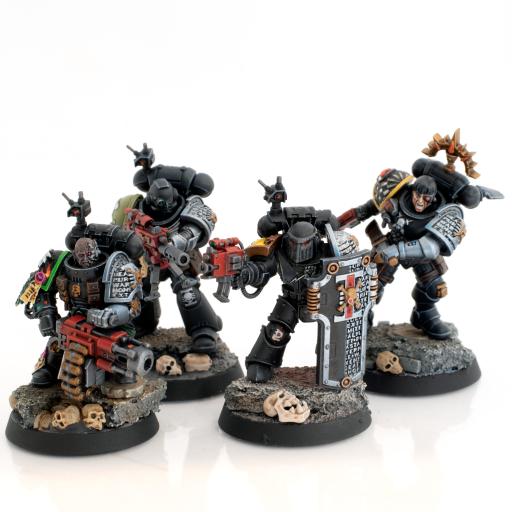
Building Kill Teams
Before we talk about the factions we need to talk about how Kill Teams are built. We mentioned this briefly in our review of the Kill Team rules and Octarius, but at the time it was difficult to really talk about Kill Team construction without understanding how it would apply to teams with a broader range of options. Now that we have the Compendium it’s worth going back over this in detail.
There are three levels of team construction in kill team:
- Your Matched Play Roster or Kill Team Dataslate, which are the larger rosters for Matched Play and Spec Ops, respectively. These are the bigger groups that your kill team will be drawn from, and where you can stash extra options and loadouts to swap into your fire teams. This is similar to the Kill Team 2018 roster, where you build a Kill Team from your roster before the game starts.
- Your Kill Team, which is the team you bring to the game and construct from your roster before the game begins. A Kill Team is built from one or more Fire Teams, and depending on the faction you may be able to take the same Fire Team more than once.
- A Fire Team is a group of operatives. These are typically a set number of models with options to choose from, such as Gunners, Heavy Gunners, Fighters, and Leaders. Each Fire Team has an Archetype or two, such as Seek and Destroy or Security, that determine the TacOps (secondary objectives) you have access to during games.
Wait, Where are the Points?
One of the first things you’ll notice as you go through the Compendium is that, similar to Octarius, there are no points values for any operatives. Instead, teams are balanced based on the options available, so for example a Chaos Space Marine Kill Team can be built from two possible Fire Team options: 3 Chaos Space Marines or 8 Chaos Cultists (limit 1). So a Chaos Space Marines Kill Team will always be made up of either 6 Chaos Space Marines or 3 Chaos Space Marines and 8 Cultists. There are options within those, but that’s the broad makeup you’re going to be looking at. You DO have a form of “points” that lets you buy equipment, but these are determined by the mission sequence – for example, the Matched Play mission sequence includes Step 9 Select Equipment, which allows you to select up to 10 points of equipment from your faction’s equipment list. These aren’t guns or melee weapons (those are on your roster), instead it’s stuff like being able to take a special kind of ammo if you have a suitable model to put it on. We’ll talk about these in more detail later, but the key point here is that these are things you can change game to game, after you already know your opponent’s Kill Team, Tac Ops, what mission you’re playing etc. so they add another layer of tailoring beyond just what operatives and fire teams you pick.
The fire teams system is a clever way to ensure that teams are balanced even with the options available for loadouts – you can plan (and, in GW’s case, balance) very deliberately around the limited number of options available for team construction much more effectively. It also means fire teams can be shaped around what actually comes in the unit boxes, so that taking up a new faction is much easier – you can just buy one box of the particular unit that is the basis of your fire team and you have the options available to you. The system also has some interesting implications for the future of the game which we’ll discuss later on.
The Factions
Kill Team Compendium covers a whopping nineteen factions, including all of the major factions in 40k that could plausibly appear in the game (sorry, Knights fans), plus one you probably didn’t expect – but may prove surprisingly popular – Kroot. In this section, we’re going to cover the factions of the Imperium, and then we’ll be covering the Chaos and Xenos factions in two other articles that we’ll publish today as well.
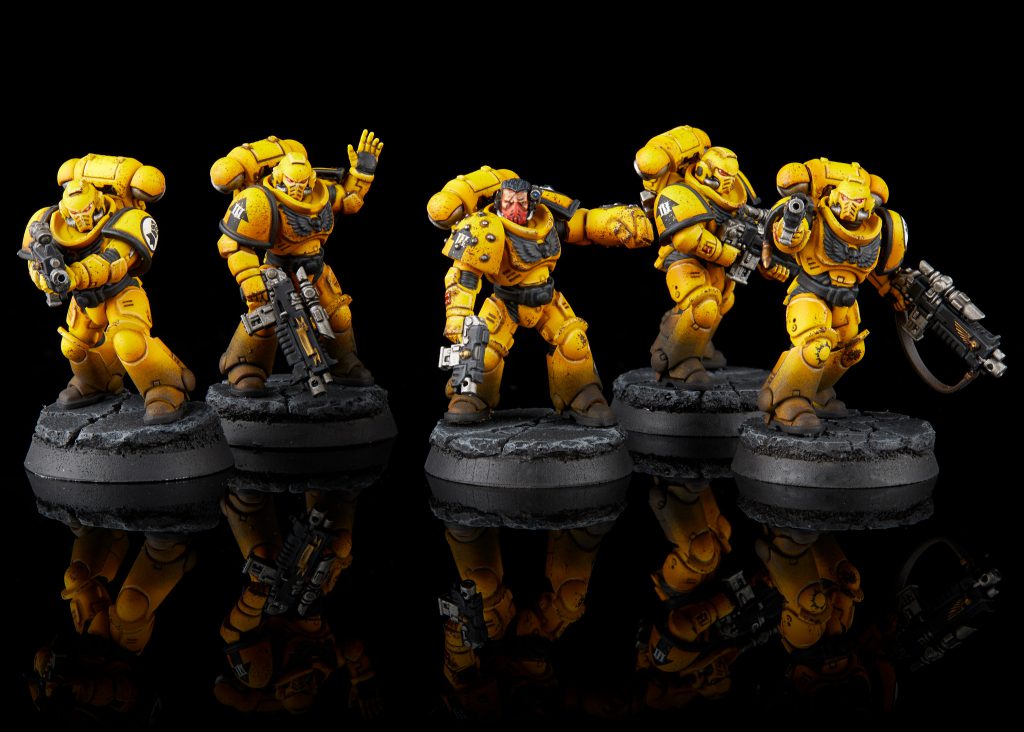
Space Marines
The first thing you’ll notice when you open the Compendium is that Space Marines have 30 pages of options compared to most other factions’ 10 or so. This may well elicit a weary sigh from you (it did from us!) but once you look at their available Fire Team options and how they’re actually constructed, you’ll feel a lot better.
A Space Marine Kill Team consists of one of the following Fire Teams:
- Five Intercessors
- Five Assault Intercessors
- Five Incursors
- Five Infiltrators
- Five Reivers
- Four Heavy Intercessors
- Six Tactical Marines
- Ten Scout Marines
- And if you’re playing Deathwatch, you can have a Fire Team of five Deathwatch Veterans.
Space Marine Kill Teams are fundamentally made from squads. If you were hoping for lots of mixing-and-matching, you’re going to be a bit disappointed, but the upside here is better game balance and the fact that buying a single box of any Marine unit will get you a fully workable Kill Team. For players interested in mixing things up a bit more, your 20-model roster can still include enough options for four different Fire Teams (or three if you take Scouts), giving you lots of pre-game flexibility.
Space Marines in Kill Team are pretty good all-rounders, and that has a lot of value. Unlike the mere mortals from teams like the Astra Militarum, Space Marines have 3 APL to work with per turn, allowing them to move, shoot, and capture an objective in the same activation, or shoot, charge, and fight, etc.. On top of that they’ve got good offense and defense plus a ton of wounds, more than making up for their limited numbers.
If you want to go with the Firstborn Marines, you get one more body and varied weapons with Tactical Marines, much more weapon flexibility (and cooler options) with Deathwatch Veterans, and twice the bodies with Scouts – though you pay for it with the latter team by giving up wounds and 1 APL per model, making them more like their non-transhuman counterparts. Regular Primaris are tough all-rounders, while the Phobos Fire Teams get the advantage of having access to three Archetypes to choose Tac Ops from, opening up broad scoring opportunities. On the other hand if you’re going heavy up with the Heavy Intercessors, you get four bodies but they come with a whopping 18 wounds each, similar to Custodes, though they’re better at shooting and a bit worse at melee.
Most of the Marine team share traits that allow operatives to either double shoot or double fight in a turn, giving them some great versatility when you need to make up for their limited numbers. Only in Death Does Duty End also makes a return here, though in a much cooler form: You use it when an operative loses all their wounds and they can stick around until the end of the next activation (presumably theirs), and act as if they aren’t injured.
Marines get two pages of equipment instead of the one that most factions get, but many of the items are locked to specific operatives, so your options in any one game are pretty limited. I’d have liked to see some more call backs to older editions, like Hellfire Shells for Scouts, but overall there are solid choices for each fire team, even if Scouts and Tactical Marines will be likely to gravitate towards grenades and suspenders most of the time at the expense of the other options.
Marines aren’t particularly exciting in Kill Team but they’re also a good starting point for what the average power level of a team should be. They’re a great team for beginners, with enough options to be competitive, and being able to unlock a new way to play by buying a single other box should keep them fresh.

Grey Knights
Space Marines with psychic powers, a Grey Knights kill team consists of a single fire team of five power-armored Grey Knights consisting of one Justicar and four other guys, one of which can be a gunner equipped with an Incinerator, psilencer, or psycannon. They also have several melee weapon options on top of their wrist-mounted storm bolters, including falchions, staves, and nemesis daemon hammers, and each has its own advantages and disadvantages.
The big upside to Grey Knights however is that every one of them is a psyker and capable of using a special action, Manifest Psychic Power (1 AP). This automatically works and you can pick one of three powers to manifest, and they all buff the model casting them:
- Armoured Resilience improves the model’s save by 1
- Hammerhand gives you +1 damage in melee on your first hit in combat
- Astral Aim gives your ranged weapons the No Cover rule
These are some decent buffs and a good way to use the third AP of an activation – the standard turn for a Grey Knight is going to look like “move > psychic power > shoot” or “psychic power > charge > fight,” where you’re boosting whatever action you’re about to take. With just a single team Grey Knights aren’t exactly overburdened with options, but what’s here provides a flexible team that should be a lot of fun to play.

Credit: Pendulin
Talons of the Emperor
One of the biggest questions we had coming into new Kill Team was how it would handle Custodes and I’m happy to say the answer is ‘pretty well.” Talons give you access to two Fire Team options: a pair of Custodes or five Sisters of Silence.
Custodes live up to their vaunted reputation in Kill Team. With 18 wounds , a 2+ save, and 4 APL per model, they’re walking tanks capable of making up for their small numbers with the ability to secure objectives, shoot, charge, and fight in the same turn. And if you’re feeling feisty, they can spend 1 CP on the Peerless Warriors Strategic Ploy to shoot and fight twice per turn, letting you do some truly crazy stuff.
If you’re not into the idea of a four-model kill team (and it does have some downsides, just in terms of the sheer area you can cover and the costs you pay per model killed), you can swap out two of our Custodes for five Sisters of Silence (or go 10 Sisters, if you prefer). Sisters have decent statlines – 8W and a 3+ save – are immune to psychic powers, and can carry bolters and flamers or some very nasty swords.
A two Custodes/five Sisters team with bolter Sisters holding the backfield objective/s and flamer Sisters supporting the Custodes in pushing towards the enemy seems like a solid strategy, combining the raw power of Custodes with the flexibility of having a few more models on the table. Talon rosters are pretty much always going to be two fire teams of 5 sisters and another 4-5 Custodes, with the final five slots likely reserved for different weapon options for either group.
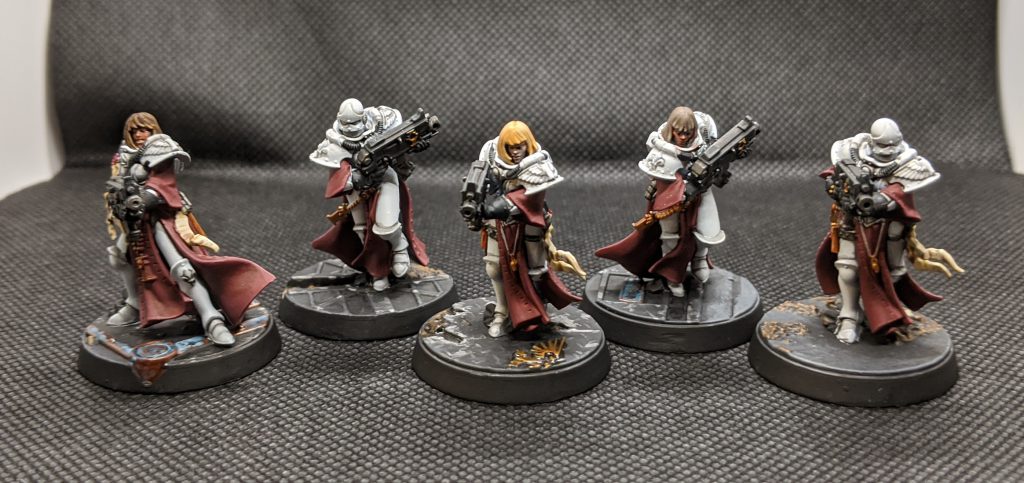
Ecclesiarchy
An Ecclesiarchy Kill Team consists of up to 2 Fire Teams chosen from either Battle Sister, Repentia, or Arco-Flagellant Fire Teams. You can take take both your choices from the first two if you want to, but Arco-Flagellant Fire Teams are max 1 per Kill Team no matter what – the dream of flinging a screaming 10 model horde of Arco-Flagellants at the enemy will have to wait for another day. Ecclesiarchy Fire Teams only get one Archetype each which limits their choice of Tac Ops compared to other, more flexible teams.
Arco-Flagellants and Repentia are extremely straightforward in how they’re constructed. Repentia Fire Teams are made up of 5 Repentia models, Arco-Flagellant Fire Teams are made up of 5 Arco-Flagellant models. A Repentia model can be your Leader (in the form of a Repentia Superior – the actual Repentia aren’t leading anybody!) but an Arco-Flagellant can’t.
The Battle Sisters offer a little more variety, with up to one Gunner per Fire Team, and one Heavy Gunner if both your Fire Teams are Battle Sisters. You can also take what appears to be an unlimited number of Icon Bearers, and one Sister Superior as a Leader. The Superior gets a pretty expansive list of equipment options – if it’s in the Battle Sister box, you can take it. It’s kind of weird that you can only take a Heavy Gunner if you have two Battle Sister team; is 5 Battle Sisters and 5 Repentia getting a Heavy Gunner really more of a big deal than 5 Kabalties and 5 Wyches with the same?
Ignoring the oddities of a team being heavily restricted on Heavy Gunners while being able to take all 5 models as Icon Bearers (which shows up elsewhere – we’re kind of expecting this to be FAQed to be one per Kill Team, since there’s no reason you’d ever take a regular Sister right now if you could take them all as Icons instead), Sisters are a reasonable force on the table. Your basic Battle Sister is exceptional only for her 3+ save, but the Icon is a force multiplier allowing you a bonus crit on a 5+ for nearby models, as well as counting extra for objective-holding. Gunners bring either meltaguns, appropriately ferocious with 4 attacks which are damage 6 base with AP2 or 3 damage + 4 mortal wounds on a critical, which is just silly – though they also have limited range of just 6 inches. If you played the Space Marine video game and remember meltaguns as being that game’s shotgun, you’ll understand what’s happening here. If you’re feeling more like fire is your thing, the flamer is equally range limited and has less damage at just 2 or 3, but even more shots and a better BS, as well as the Torrent rule allowing it to splash onto nearby enemies. The humble storm bolter sits between the two, with the advantage of being a regular gun and therefore having infinite range, and trading big damage spikes or multi-model attacks for the Relentless rule, giving you re-rolls on your attack dice, which are a big boost for consistency.
Repentia trade all this away in order to swing a big eviscerator. They’re quite flimsy, with a 6+ save and only 7 wounds compared to the Battle Sisters’ 8, though they also get a 5+ to ignore wounds which will help keep them ticking. If the eviscerator connects, though, your opponent will know about it; even regular hits are doing 5 damage, with crits doing 6, and its Brutal rule means only criticals can parry its attacks while Reap 2 lets you splash a potentially gross number of mortal wounds onto nearby enemies.
Arco-Flagellants fulfil a similar role, but their weapons are slightly less brutal – and indeed not Brutal – and being unable to perform mission or Pick Up actions, on account of not having hands. They’re all 10 wounds each, though, so putting down a Fire Team of them offers you 50 wounds with a 5+ to ignore wounds taken, and while their arco-flail attacks are less hard-hitting than the penitent eviscerator, they get 5 rather than 4 and are much more accurate with WS3+ instead of 4+ and Ceaseless letting them re-roll 1s on their attack dice.
Your Strategic and Tactical Ploys offer a similar kind of consistency – the Emperor’s Guidance SP allows your operatives to re-roll one attack dice if they made any crits with shooting, while Divine Shield does similar for save rolls. Divine Intervention is a Tactical Ploy which goes even further, allowing you to simply ignore the damage from one attack completely.
These, and some of your equipment choices (such as the Rosarius to give your Leader a 4+ invulnerable save, or the Phial of Restoration to allow an operative to heal 2d3 wounds once per game) will keep your Ecclesiarchy operatives on the table a lot longer than their statlines suggest, mirroring their toughness in 40k. It makes for an interesting Kill Team, with relatively weak shooting – especially since you’ll need to take 10 Battle Sisters to be able to access a heavy bolter or Ministorum heavy flamer-toting Heavy Gunner – but which will keep on ticking past the point you’d expect them to, and with the potential for some horrific melee damage if Repentia or Arco-flagellants are allowed to get up close.
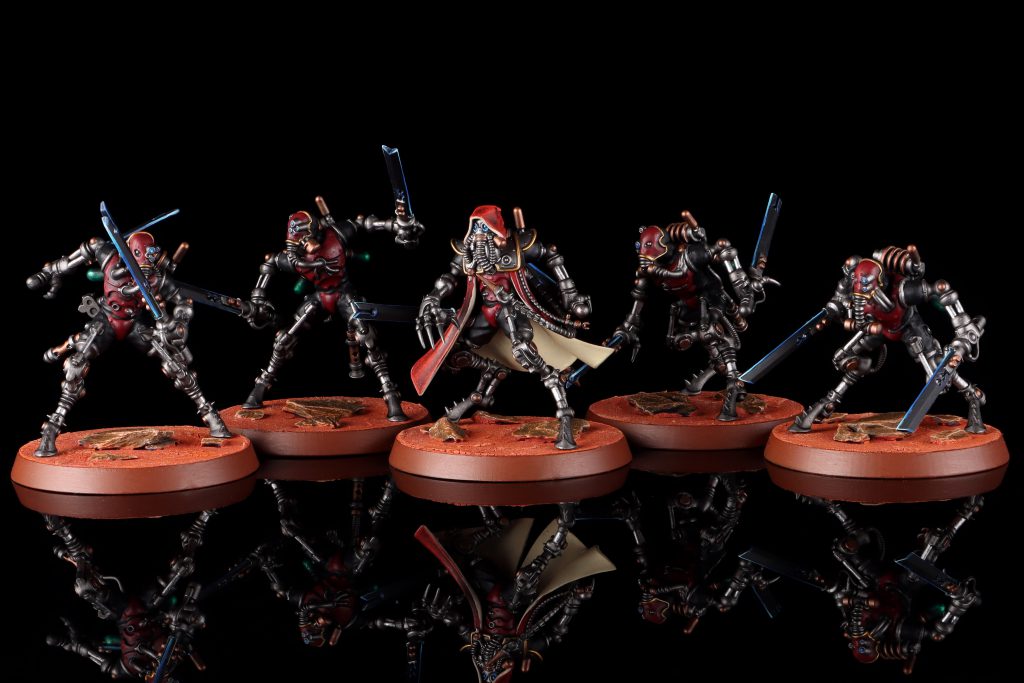
Forge Worlds
Forge World kill teams consist of two Fire Teams chosen from three options: 5 Rangers, 5 Vanguard, or 4 Sicarians in whatever combination you like. Any one of these options can take a Leader, but you’ll likely want to avoid taking one from the Sicarians: while the Sicarian Princeps replaces a model in your fire team, the Ranger or Vanguard Alpha is in addition, giving you 6 models in the team you put them in.
Rangers and Vanguard come in three flavors each: Troopers, Gunners, and Leaders, and the choice in which you bring is largely down to personal preference, as both the galvanic rifle and the radium carbine have their pros and cons. Both Alphas also get to choose from a set of pistols and melee weapons with various useful rules, including a couple with the Stun trait, which will be a fun way to ruin your opponent’s day: Stun weapons give a target -1 APL if you roll a critical hit during the attack. On four shots, those aren’t bad odds.
The Gunners are the real attraction here, though: each fire team can take two gunners, and each gunner gets to choose from the arc rifle, plasma caliver, and transuranic arquebus. They’ve all got their uses, and they’re all relatively nasty. The Arc Rifle can’t supercharge like the Caliver but it’s got 4 shots at AP1 with Stun and a damage profile of 4/5. And the Arquebus is Heavy and Unwieldy but it’s AP1 and will do 2 mortal wounds when you crit, plus it hits on a 2+. The plasma is, well, plasma, and is a great all-rounder weapon.
Ruststalkers and Infiltrators come in smaller groups and have fewer options to choose from, but they pack a few extra wounds and the weapon choices they do have are pretty good. Of the two, you’ll probably want to lean more into Infiltrators than Ruststalkers, but the Ruststalkers have the statline to make short work of most non-melee specialists.
The Strategic Ploys available to you are the Doctrina Imperatives from the 9th Edition Codex, adapted to fit the Kill Team rules: the bonuses allow you to re-roll failed dice, while the penalties force you to re-roll successes. For example: Protector Imperative lets you re-roll a single attack die when each model shoots, but forces all of your models to re-roll a single successful hit when they fight in combat. Your Tactical Ploys are even better, letting you manipulate the order in which models activate to your advantage.
Of course, no Forge World would let their crack operatives go into the field without being equipped properly, and the equipment selection these Kill Teams have access to is really good. Of particular note are the two restricted options: the Omnispex and the Data-Tether. Each one gives the operative that it’s equipped with a new action. The Omnispex lets the operative spend 1AP to let a nearby friendly model treat its target as not being Obscured and give its weapon the No Cover rule. If you’re looking for something simpler, the Data-Tether might be your speed: it gives your model a 1AP action to gain 1CP. It’s expensive at 4EP, but worth the cost.
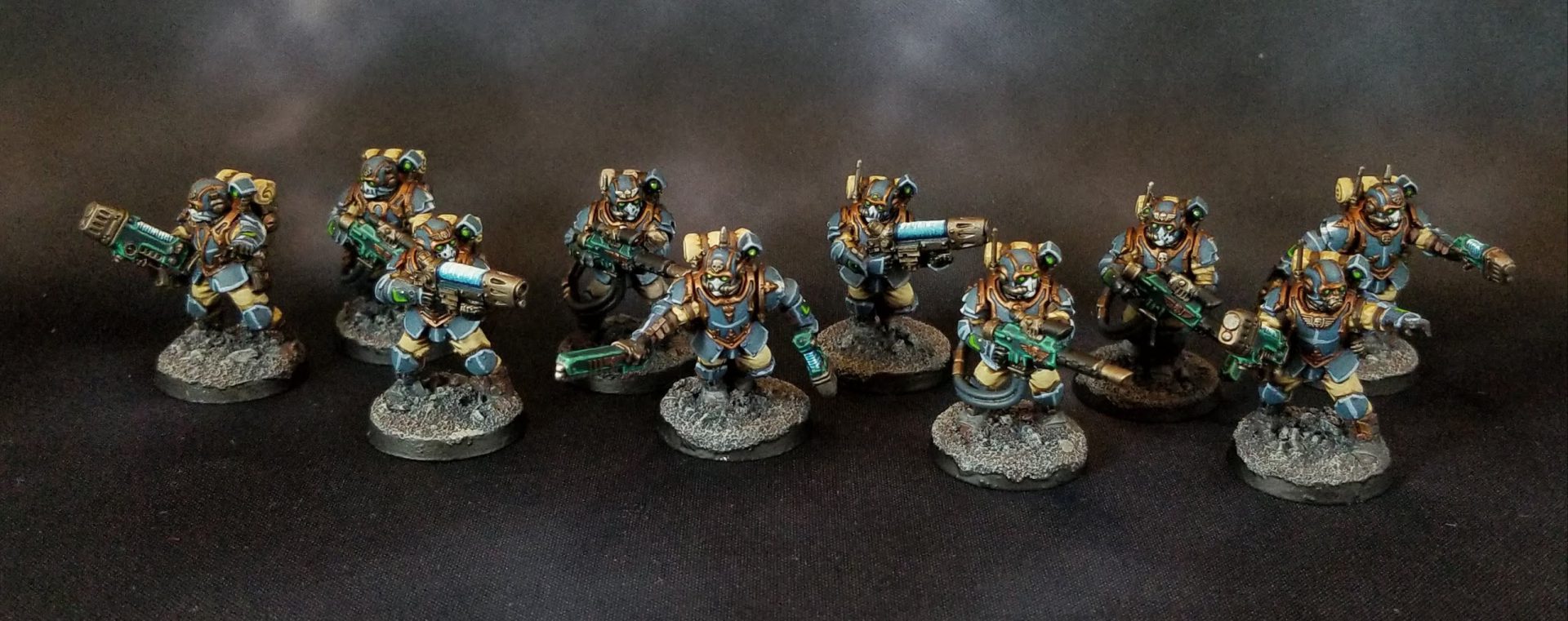
Imperial Guard
If Veteran Guardsmen aren’t your team, there’s regular guard teams, which can confusingly contain highly-trained veterans of their own. They don’t get all the bells and whistles that Veteran Guardsmen get like being able to call in airstrikes, but they make up for that with their versatility. A Guard team consists of two Fire Teams picked from Guardsmen and Scions, and you can double up on either if you like. A guardsman fire team is seven models and a scions fire team is five. Your Guardsman fire team can include up to three non-trooper options, which means you can have up to three gunners per fire team, but you can’t double up on their weapons. The options you get are the standard guardsman set: Flamers, grenade launchers, sniper rifles, meltaguns, and plasma guns. You can also take a Comms Guardsman, who can spend 1 AP to give 1 APL to another operative or pass orders along to the whole team.
Note: Currently it appears there is a typo for Guardsmen in the Compendium – Guardsman Gunners are listed as having a 3+ save but this is likely meant to be 5+. We suggest playing this as a 5+.
The Tempestus Scions are tougher than their standard guardsmen brothers, sporting +1 wound and a 4+ save, and their hot-shot lasguns hit on 3+ instead of 4+. Scion gunners can take most of the same suite of weapons as their lower rank brothers as well, but have better accuracy.
Guard teams are somewhat unique in that they only have one Tactical Ploy – Bring It Down! Which lets you re-roll hits against a target you’ve already started shooting, but five Strategic Ploys that represent orders given to the squad. Oddly, using these currently requires a Guardsman Sergeant to work – though Tempestus Scion Operatives are able to benefit, Tempestors cannot issue them. These are all pretty good, especially if you have a Comms specialist to extend their range. Take Aim! Lets you re-roll 1s to hit when shooting, Move! Move! Move! Gives your operatives an extra 1” of Movement.
Because of the way orders work, it’s a bit more difficult to imagine you’d want to take a guard team that doesn’t include a fire team of standard guard just because not doing so locks you out of issuing orders and essentially doing much of anything with your CP besides re-rolling and focus firing down targets.
Next Up: Chaos
As we mentioned, we’ve split this review into three parts in order to cut down on the length of each part and make it easier to find the factions you’re looking for. In part 2 – also out this morning, we’ll cover Chaos factions, then we’ll cover Xenos and our final thoughts in part 3. In the meantime, if you have any questions or feedback, Drop us a note in the comments below or email us at contact@goonhammer.com.

